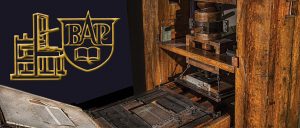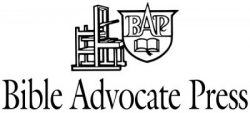
In 2013 the Bible Advocate Press celebrated it 150 year of service to the church. LeRoy Dais looked back into the history of the BAP during those years. You can read the entire issue at baoline.com archives July – August 2013 issue.
The birth of The Hope of Israel, forerunner of the Bible Advocate, was the product of dedication and sacrifice. The early Michigan Conference decided that brethren of a common Christian faith should publish a paper to share the gospel. For the first twenty-five years, members provided both financial support and hours of tedious labor. Enos Easton was named the first editor, and H. S. Dille served as office editor, as well as printer, promoter, and businessperson. Gilbert Cranmer, an active preacher and evangelist, was instrumental in helping start The Hope and served as editor for several months.
The first issue (dated August 10, 1863, Hartford, Michigan) was mailed to fewer than forty homes. It quickly became an avenue of communication between like-minded, Sabbath-observing brethren searching for fellowship and eager to share the truths of Scripture. Within a short time, this fledgling paper was distributed to homes in eighteen states.
During and after the Civil War, many who received the paper lacked the ability to pay its seventy-five-cent subscription price, but it was sent even if they couldn’t pay.
Iowa, Missouri
After production in Michigan for two years, The Hope was discontinued for a time. Brethren in Marion, Iowa, connected through their support and writings, formed a publishing association and resumed its production in May 1866. They started with a new volume number 1. Thus, the current volume number is 147, not 150.
A larger press was soon purchased. An outstanding pioneer in this work was Jacob Brinkerhoff. When the printing equipment was put up for sale to settle the association’s mortgage in 1874, he had already served as office editor three years. Through deep commitment to this ministry, he and his wife purchased the equipment and supplies with funds they had saved to purchase a home. Elder Brinkerhoff became the owner, publisher, editor, and printer of the magazine for the next thirteen years.
In 1887 Elder A. C. Long became editor. The next year, the Church’s General Conference purchased the equipment, moved it to Stanberry, Missouri, and took on the publishing responsibility. Elder W. C. Long soon became the editor. In 1898 the operation was officially named the Church of God Publishing House.
That name was changed to Bible Advocate Press in 1965, for its flagship publication. The BAP remained in Stanberry until the entire operation and most of the staff moved to a Denver, Colorado suburb in 1972. Moving from a quiet little town to a large metropolis was quite a change, but the larger facility allowed for necessary expansion. It also provided for closer coordination with other ministries of the Church through the General Conference offices.
The Hope of Israel underwent its fifth and final name change in 1972, from Bible Advocate and Herald of the Coming Kingdom to Bible Advocate. In 1970 the magazine became free to all who requested it. Since 2001 the magazine has been published in Spanish. In 1996 portions of the Bible Advocate were used to create BA Online. That evolved into putting the entire magazine online so it can be read by anyone with computer access, without receiving the printed copy through the mail. The BA staff also reaches potential readers via Facebook.
Publications
Other publications gradually were added to The Hope. In 1864 The Little Preacher was published for children, but we don’t know how long it continued. Through the efforts of Mrs. Jacob Brinkerhoff, The Sabbath School Missionary was started in 1884 to provide Bible stories and lessons for children. In 1970 it was replaced by Footprints magazine. The latter did not contain lessons because at that time, the press was providing Bible curriculum from other publishers.
Introduced in 1923, The Harvest Field Messenger provided reports about gospel work throughout the Church, including mission fields. Starting in 1969, The Messenger was mailed to all Church members without charge.
The Christian Youth Herald and Gospel Call, a magazine for youth, was introduced in 1935, though there may have been an earlier youth magazine. The Call was replaced by AIM magazine in 1959.
Footprints, AIM, and WAND (a magazine for women) were discontinued in 1978. Portions of them were incorporated in The Messenger for a time, but because of increasing costs of production, The Messenger ended in early 1993.
Gospel literature
Gospel literature for evangelism and Bible study has been made available from the early years. Over the past several decades, hundreds of thousands of gospel tracts and booklets have been printed and distributed each year, with a large percentage going to other countries. These “little messengers” are effective for evangelism efforts, Bible studies, spiritual nurturing, and encouragement. The printed word has a unique benefit in that it waits patiently for someone to pick it up and read it. The Holy Spirit has often used a printed message to bring repentance to a reader.
In earlier years tracts were sold at a small price, but since 1959 they have been distributed without charge. Contributions to the BAP Literature Fund provide the necessary finances.
Bible curriculum
The Adult Sabbath School Quarterly was started in 1915 to provide Bible lessons for Sabbath schools around the country. Today it is known as Bible Studies for Adults. Bible Studies for Senior Youth carries the same volume number as the adult lessons, but we suspect it started under a different name.
A new junior quarterly was introduced in 1958 but apparently was discontinued when the BAP started providing curriculum from other publishers. Bible Studies for Junior High Students was introduced in 1972.
Gradually, Sabbath school teachers tired of using curriculum from other publishers because they did not include some of the basic beliefs and teachings of the Church of God (Seventh Day), so some teachers started creating their own lessons. Appeals became more frequent to develop our own lessons for children. In 2006 Conference President Whaid Rose appointed a Christian Education Committee to develop plans for creating curriculum. The goal was to provide lessons that would help build firm foundations based on Bible truths, starting with children at a young age.
A very small crew has worked diligently, recruiting writers, graphic designers, and consultants. In the fall of 2010 the new intermediate lessons for grades 4, 5, and 6 were made available to our Sabbath schools. A year later the primary lessons for grades 1, 2, and 3 were introduced. Both the primary and intermediate lessons will be on a three-year cycle for these specific age groups. Instead of printing them in booklet form, the lessons are provided via e-mail attachments or on disks, and each local church prints the number of copies needed for its students.
Reflections
The action of believers in Michigan in 1863 started a cycle of blessings: God blessed the believers with the inspiration to begin a publication; a few were blessed in obediently performing the task of producing the paper; those who received the product of their labors, The Hope, were blessed in receiving it; they in turn blessed the laborers with their writings and support. God was involved in every phase of this cycle, and the cycle has continued to this day. The Lord does His work through His people.
The BAP has never had a surplus in finances, nor the ability to vastly expand, but the Lord has always provided adequately to continue operation. Just as individuals encounter obstacles along the way, Bible Advocate Press has had its own encounters with trouble over one hundred fifty years. But the Lord opened new doors each time: to increased funding, to a larger facility, and to more efficient equipment that provided for growth and an expanded field of ministry.
Innovations in the world around us also benefit the gospel work. We are now capable of providing the Bible Advocate, literature, and Bible lessons in digital format. The younger generation is most familiar with the electronic methods of getting and giving information. After working on a computer all day, I still prefer to hold a magazine or tract in my hand to read. I think the need for the printed gospel word will be here for a long time to come. Still, the Bible Advocate Press must use all available avenues to nurture believers and reach those who need the Savior.
I have been blessed to be a part of this work of the Lord. May He bless our staff with wisdom to adapt to future innovations and vision to continue this ministry until the Lord Jesus Christ returns to receive His own unto Himself.
